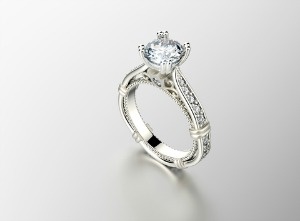 For many people, marriage is a blessed arrangement, a dream within a dream...
For many people, marriage is a blessed arrangement, a dream within a dream...
For the jewelry industry, it’s a major driver of sales.
According to some estimates, 95% of couples exchange rings along with marriage vows, and the “gold standard” for the majority of US brides is a ring encrusted with at least one diamond.
Thus, US personal consumption expenditures (in nominal terms) on jewelry are expected to advance 3.1% annually to 2020 as the number of new marriages continues to grow.
The relationship between new marriages and jewelry expenditures isn’t always easy; both suffered as the US recession weighed down consumer spending and confidence in the future. In 2009, the number of new marriages in the US fell 3.6% in 2009 to a trough for the 2005-2015 decade. Personal spending on jewelry in nominal and real terms declined 7.5% and 9.5%, respectively, that year.
Millennials Say Yes to Bluetooth Over Bling
Although more people are now saying “I do,” jewelry suppliers must contend with demographic factors that constrain sales growth. According to the Pew Research Center, in 2013, 26% of millennials were married versus 48% of baby boomers at the same time in their lives — a delay that limits the demand for bridal jewelry.
Spending on jewelry is also restrained by this cohort’s decline in median earnings and a growing preference for purchasing electronics and experiences (such as vacations) instead of fine jewelry.
But All That Glitters Looks Golden
Nevertheless, jewelry suppliers will be able to stimulate sales by capitalizing on key trends. For example, as business formal gives way to business casual, and people dress more casually in general, jewelry makers are responding with pieces that feature the high-quality characteristic of fine jewelry with the fashion-forward appeal of costume, or fashion, jewelry.
One such example of this approach is the Tiffany T collection launched by jeweler and retailer Tiffany & Co in 2014, which features fine jewelry items crafted from precious metals and gemstones with modern, geometric designs.
Other Trends to “Watch” Out for
Now let’s talk about that other popular accessory: the watch. It serves as a means of telling time but also, quite often, a suitable gift for special occasions (such as graduations) and a wearable symbol of status. Nothing new there.
But growth in personal spending on watches is expected to be robust over the forecast period, bolstered by gains in disposable personal income and a “micro-brand” watch trend that is enticing many consumers to purchase watches.
To learn about this and other trends spurring US jewelry and watch expenditures, see Jewelry & Watches: United States, a report by the Freedonia Focus Reports division of The Freedonia Group. This report forecasts US personal consumption expenditures on jewelry and watches in nominal and real (inflation-adjusted) terms to 2020, discusses market drivers and constraints, and profiles leading companies.
About the Author: Erica Keenan is a Research Analyst with Freedonia Focus Reports. She holds a bachelor’s degree in biology and a master’s degree in pathology, and has worked in the biomedical science and real estate industries as a scientist and research analyst.

